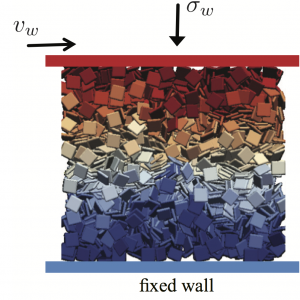Mauricio Boton, Emilien Azéma, Nicolas Estrada, Farhang Radjaï and Arcesio Lizcano, PHYSICAL REVIEW E 87, 032206 (2013)

Shear test with platy particles
This is the first paper of a series devoted to the micro-mechanical modeling of clayey soils, by means of discrete element simulations. We specifically focus here on the effect of the platy shape of particles by reducing the interactions between particles to mechanical contact forces (i.e., neither electrostatic repulsion nor van der Waals forces are taken into account). The particles are three-dimensional square plates, approximated as spheropolyhedra. Several samples composed of particles of different levels of platyness (related to the ratio of length to thickness) were numerically prepared and sheared up to large deformations. We analyzed the shear strength, packing fraction, orientation of the particles, connectivity, fabric of the interactions network, and interaction forces as functions of the platyness. We find that both the mechanical behavior and microstructure are strongly dependent on the degree of platyness. The principal underlying phenomenon is the alignment of particle faces along a particular direction. This ordering phenomenon, which emerges even for shapes that deviate only slightly from that of a sphere, enhances the ability of the packing to develop an anisotropic structure leading to large shear strength, especially as a consequence of the fabric and mobilization of friction forces. Moreover, the connectivity of the packings and their packing fraction also evolve with the platyness. In particular, the packing fraction evolves in a nonmonotonic fashion, as observed in other granular materials composed of elongated or angular particles.